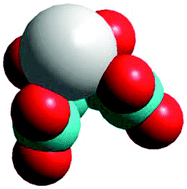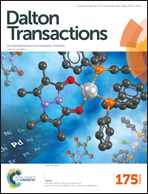Calcium l-tartrate complex formation in neutral and in hyperalkaline aqueous solutions†
Abstract
The complex formation reaction between the L-tartrate (Tar2−) and calcium ions taking place in neutral and in hyperalkaline (pH > 13) aqueous solutions has been investigated. It was demonstrated that upon NaOH addition the solubility of the CaTar(s) precipitate significantly increases. Conductometric and freezing point depression measurements further confirmed that in this process water soluble species are formed as a result of a reaction between the CaTar(s) and the hydroxide ion (or, conversely, between Ca(OH)2(s) and the Tar2− ion). 13C NMR spectroscopic measurements yielded the value of pK3 = 15.4 ± 0.2 for the proton dissociation of one of the alcoholic OH groups of Tar2− (at 25.0 °C and 4 M Na(Cl) ionic strength). Upon addition of calcium ions to an alkaline Tar2− solution, the 1H NMR signal gradually broadened and the 13C-satellite peaks split to two components, which also indicate complexation. From H2/Pt potentiometric titrations performed with solutions in the 13.6 ≤ pH ≤ 14.4 range, it was observed, that this complex formation is accompanied by a hydroxide ion consuming process. The titration curves can be best described via assuming the formation of the CaTarH−1−(aq) (lg β11−1 = −11.2 ± 0.1) and CaTarH−22−(aq) (lg β11−2 = –25.3 ± 0.1) complexes. In hyperalkaline solutions, these two species account for more than 90–99% of the calcium ions present and the contribution of the other reasonable and well-established calcium-containing solution species is rather small. The possible structures of the above complexes have been modeled via ab initio calculations. The stoichiometries are consistent both with species containing coordinated alcoholate group(s) and with mixed Ca(II)-hydroxo-tartrato complexes. From the data available at present, both types of structures can be considered as chemically reasonable.


 Please wait while we load your content...
Please wait while we load your content...